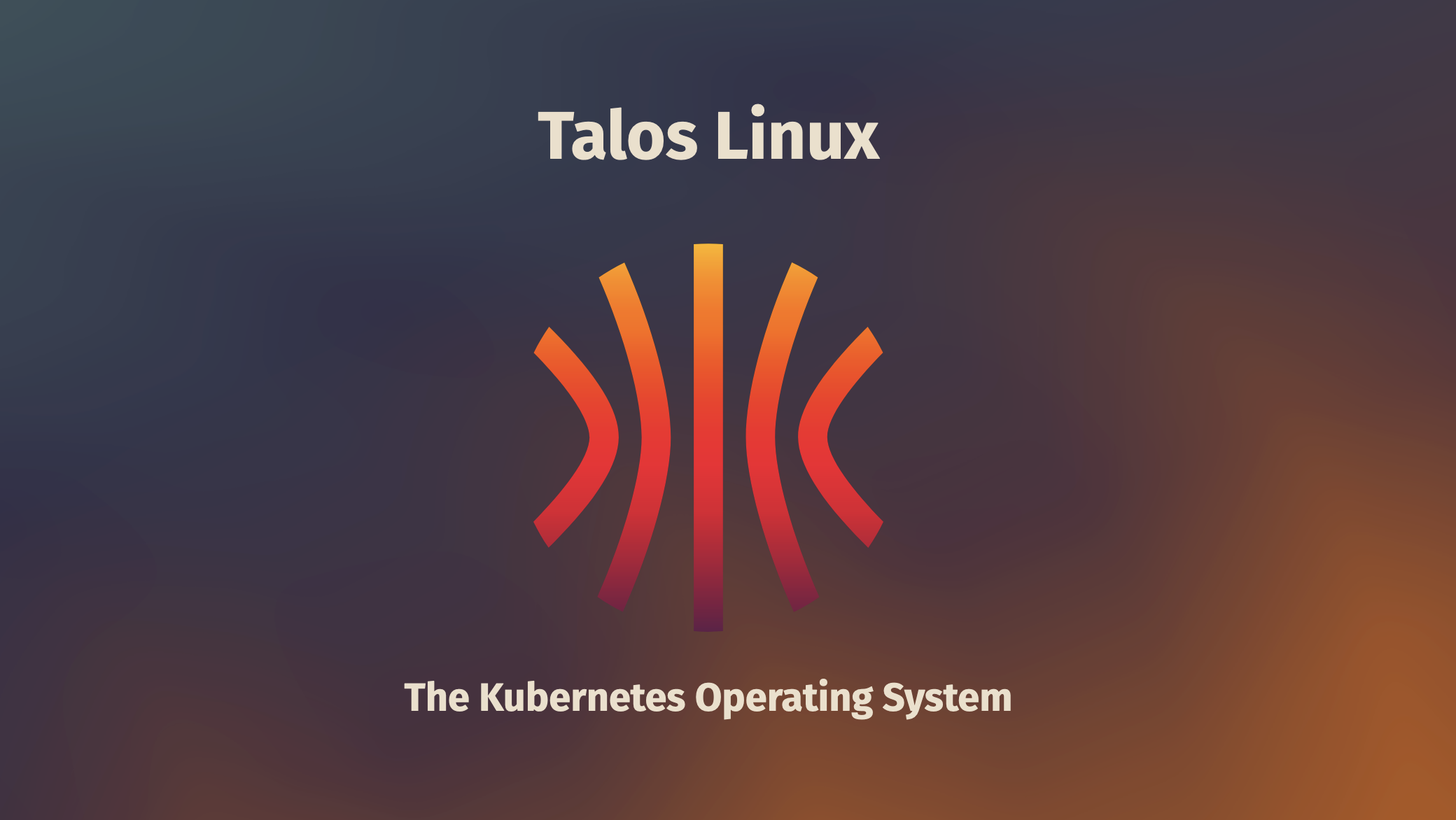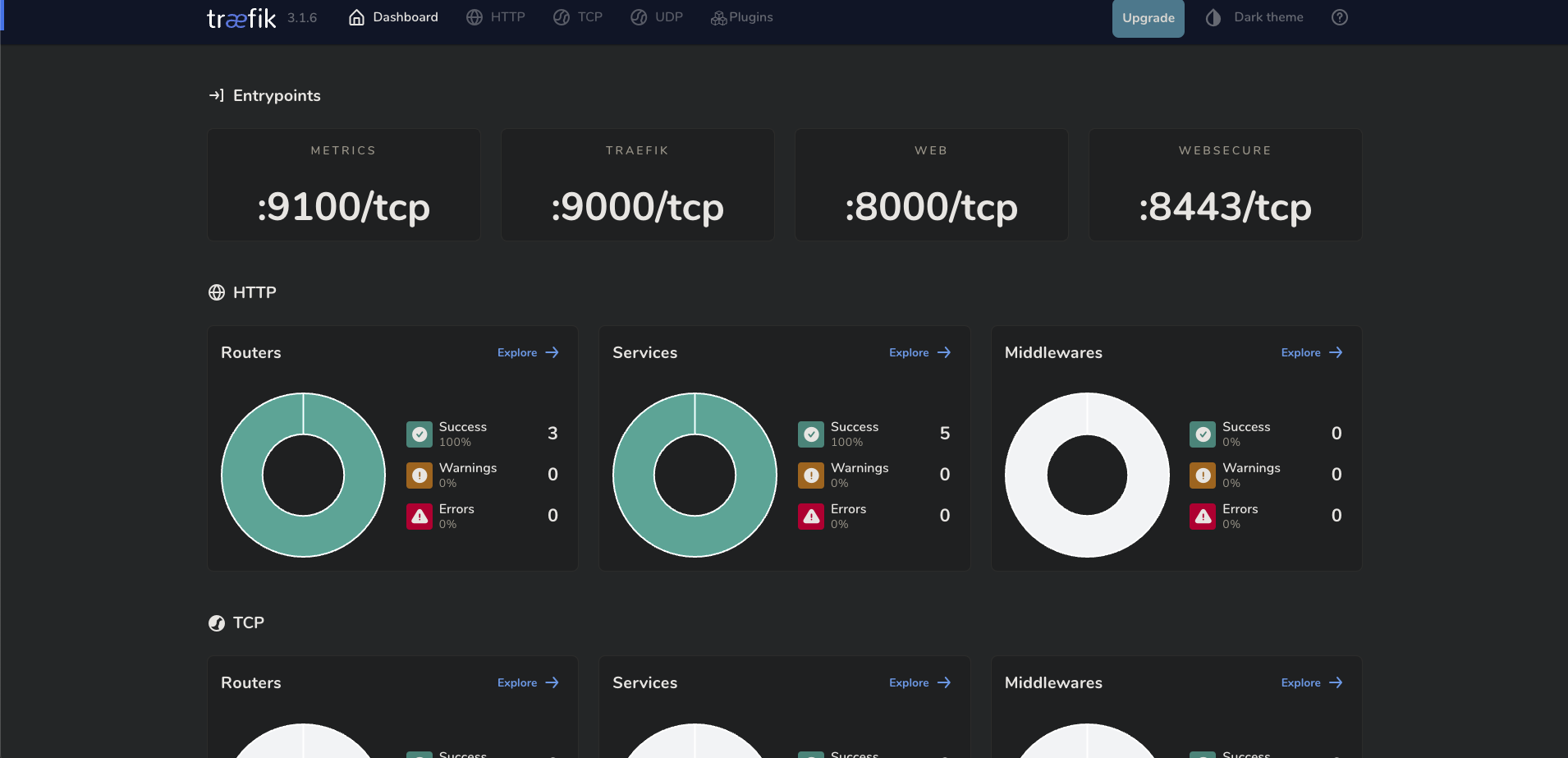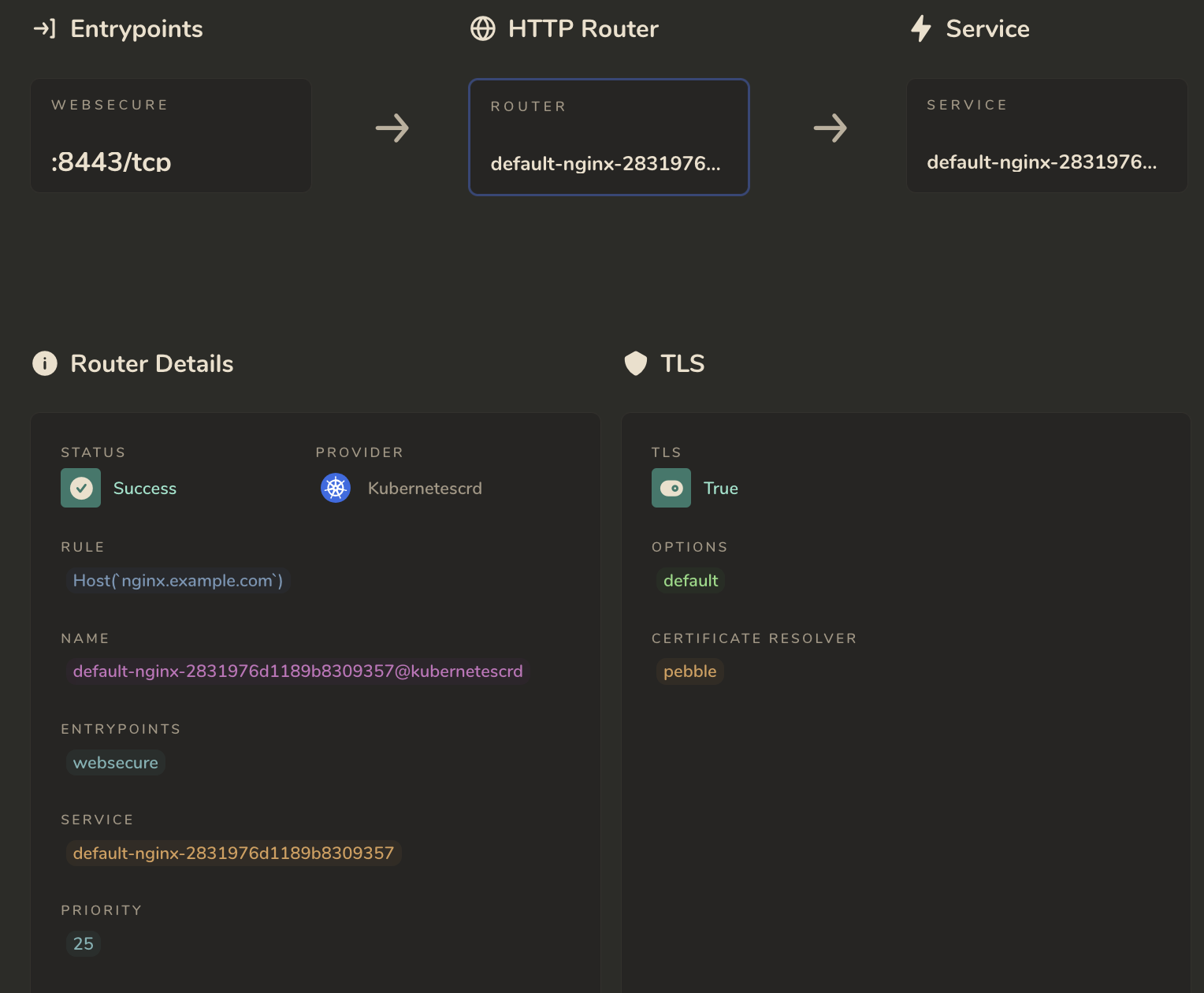Getting Started
Go to release page to download the latest OS .iso
https://github.com/siderolabs/talos
Docs:
https://www.talos.dev/v1.8/introduction/getting-started/
Prerequisites
Install Talosctl
1
| curl -sL https://talos.dev/install | sh
|
Ref: https://www.talos.dev/v1.8/talos-guides/install/talosctl/
Installation
talos kubernetes infra example
I am using my mac to be a commander. taloscp and taloswk installed in my pve with 2 cores and 4GB ram.
1
2
3
4
5
6
7
8
9
| taloscp ip:
10.0.50.101
taloswk ip:
10.0.50.102
10.0.50.103
export CONTROL_PLANE_IP=10.0.50.101
export WORKER_NODE_1_IP=10.0.50.102
export WORKER_NODE_2_IP=10.0.50.103
|
CNI
The default installation used flannel and kube-proxy in k8s cluster.
If your want to control the ingress, egress network policies,
you can deploy Cilium
Default way
1
| talosctl gen config talos-promox-cluster https://CONTROL_PLANE_IP:6443 --output-dir _out
|
Install Cilium way
Create a patch.yml, disable kube-proxy
1
2
3
4
5
6
| cluster:
network:
cni:
name: none
proxy:
disabled: true
|
Run this command to gen config.
1
| talosctl gen config talos-promox-cluster https://CONTROL_PLANE_IP:6443 --config-patch @patch.yaml --output-dir _out
|
Applying config
1
2
| root@commander:~# ls _out
controlplane.yaml talosconfig worker.yaml
|
Create the control plane from the output of the gen config command.
1
| talosctl apply-config --insecure --nodes $CONTROL_PLANE_IP --file _out/controlplane.yaml
|
Create the worker node from the output of the gen config command.
1
| talosctl apply-config --insecure ---nodes $WORKER_NODE_1_IP -nodes $WORKER_NODE_2_IP --file _out/worker.yaml
|
Set the API Server via a Config for Kubeconfig.
1
2
3
4
5
6
| export TALOSCONFIG="_out/talosconfig"
talosctl config endpoint $CONTROL_PLANE_IP
talosctl config node $CONTROL_PLANE_IP
|
Bootstrap Etcd.
Download the Kubeconfig from my cluster.
Test to confirm that the Kubeconfig is valid.
1
| kubectl get nodes --kubeconfig=kubeconfig
|
You can see the Pod output to confirm that the cluster is running as expected.
1
| kubectl get po -n kube-system --kubeconfig=kubeconfig
|
Output should look similar to the below:
Flannel & kube-proxy
1
2
3
4
5
6
7
8
9
10
| NAME READY STATUS RESTARTS AGE
coredns-68d75fd545-xhwrg 1/1 Running 0 3m41s
coredns-68d75fd545-zx6jn 1/1 Running 0 3m41s
kube-apiserver-talos-e3j-66i 1/1 Running 0 3m17s
kube-controller-manager-talos-e3j-66i 1/1 Running 2 (4m5s ago) 2m31s
kube-flannel-65tr9 1/1 Running 0 3m37s
kube-flannel-sxv6t 1/1 Running 0 3m28s
kube-proxy-b8b2f 1/1 Running 0 3m28s
kube-proxy-tt8jp 1/1 Running 0 3m37s
kube-scheduler-talos-e3j-66i 1/1 Running 2 (4m5s ago) 2m23s
|
Cilium
cilium-cli
1
2
3
4
5
6
7
8
9
| cilium install \
--set ipam.mode=kubernetes \
--set kubeProxyReplacement=true \
--set securityContext.capabilities.ciliumAgent="{CHOWN,KILL,NET_ADMIN,NET_RAW,IPC_LOCK,SYS_ADMIN,SYS_RESOURCE,DAC_OVERRIDE,FOWNER,SETGID,SETUID}" \
--set securityContext.capabilities.cleanCiliumState="{NET_ADMIN,SYS_ADMIN,SYS_RESOURCE}" \
--set cgroup.autoMount.enabled=false \
--set cgroup.hostRoot=/sys/fs/cgroup \
--set k8sServiceHost=localhost \
--set k8sServicePort=7445
|
Check cilium status:
1
2
3
4
5
6
7
8
9
10
11
12
13
14
15
| cilium status
/¯¯\
/¯¯\__/¯¯\ Cilium: OK
\__/¯¯\__/ Operator: OK
/¯¯\__/¯¯\ Envoy DaemonSet: disabled (using embedded mode)
\__/¯¯\__/ Hubble Relay: disabled
\__/ ClusterMesh: disabled
Deployment cilium-operator Desired: 1, Ready: 1/1, Available: 1/1
DaemonSet cilium Desired: 2, Ready: 2/2, Available: 2/2
Containers: cilium-operator Running: 1
cilium Running: 2
Cluster Pods: 3/3 managed by Cilium
Image versions cilium quay.io/cilium/cilium:v1.13.3@sha256:77176464a1e11ea7e89e984ac7db365e7af39851507e94f137dcf56c87746314: 2
cilium-operator quay.io/cilium/operator-generic:v1.13.3@sha256:fa7003cbfdf8358cb71786afebc711b26e5e44a2ed99bd4944930bba915b8910: 1
|
Enable hubble ui
1
| cilium hubble enable --ui
|
Run kubectl get pod -n kube-system --kubeconfig=kubeconfig
1
2
3
4
5
6
7
8
9
10
11
| NAME READY STATUS RESTARTS AGE
cilium-696nl 1/1 Running 0 3m41s
cilium-c5lc2 1/1 Running 0 3m41s
cilium-operator-777fccb4f8-z4c8b 1/1 Running 0 3m17s
coredns-68d75fd545-75wk4 1/1 Running 0 2m31s
coredns-68d75fd545-xqsst 1/1 Running 0 3m37s
hubble-relay-7bd98d9b74-hc6kd 1/1 Running 0 3m28s
hubble-ui-7868f68687-5k9rk 2/2 Running 0 3m28s
kube-apiserver-talos-cp 1/1 Running 0 3m37s
kube-controller-manager-talos-cp 1/1 Running 4 (4m5s ago) 2m23s
kube-scheduler-talos-cp 1/1 Running 2 (4m5s ago) 2m23s
|
Provisioning
- Copy you kubeconfig
cp kubeconfig ~/.kube/config - alias kubectl
~/.bashrc or ~/.zshrc & source ~/.bashrc or source ~/.zshrc alias k="kubectl"
- Docs: https://metallb.universe.tf/installation/
1
| kubectl apply -f https://raw.githubusercontent.com/metallb/metallb/v0.14.8/config/manifests/metallb-native.yaml`
|
Configuration
- Docs: https://metallb.universe.tf/configuration/
- Create a simple addresses pool in
metallb.yml
1
2
3
4
5
6
7
8
9
10
11
12
13
14
15
16
17
18
| ---
apiVersion: metallb.io/v1beta1
kind: IPAddressPool
metadata:
name: first-pool
namespace: metallb-system
spec:
addresses:
- 10.0.50.80-10.0.50.90
---
apiVersion: metallb.io/v1beta1
kind: L2Advertisement
metadata:
name: example
namespace: metallb-system
spec:
ipAddressPools:
- first-pool
|
- Run this.
k create -f metallb.yml
1
2
| k create deploy nginx --image nginx
k expose deploy nginx --port 80 --type LoadBalancer
|
1
2
3
4
| root@commander:~# k get svc
NAME TYPE CLUSTER-IP EXTERNAL-IP PORT(S) AGE
kubernetes ClusterIP 10.96.0.1 <none> 443/TCP 11h
nginx LoadBalancer 10.98.9.134 10.0.50.80 80:32599/TCP 6s
|
curl 10.0.50.80
1
2
3
4
5
6
7
8
9
10
11
12
13
14
15
16
17
18
19
20
21
22
23
24
25
26
27
28
29
30
31
32
| <!doctype html>
<html>
<head>
<title>Welcome to nginx!</title>
<style>
html {
color-scheme: light dark;
}
body {
width: 35em;
margin: 0 auto;
font-family: Tahoma, Verdana, Arial, sans-serif;
}
</style>
</head>
<body>
<h1>Welcome to nginx!</h1>
<p>
If you see this page, the nginx web server is successfully installed and
working. Further configuration is required.
</p>
<p>
For online documentation and support please refer to
<a href="http://nginx.org/">nginx.org</a>.<br />
Commercial support is available at
<a href="http://nginx.com/">nginx.com</a>.
</p>
<p><em>Thank you for using nginx.</em></p>
</body>
</html>
|
Delete Nginx
Longhorn
Longhorn is a lightweight, reliable and easy-to-use distributed block storage system for Kubernetes.
Upgrade Image
Go to https://factory.talos.dev/
Choose the iscsi-tools and util-linux-tools, then copy the #Talos Linux Upgrade provided image.
factory.talos.dev/installer/613e1592b2da41ae5e265e8789429f22e121aab91cb4deb6bc3c0b6262961245:v1.8.3
1
| talosctl upgrade -n 10.0.50.101 -n 10.0.50.102 -n 10.0.50.103 --image factory.talos.dev/installer/613e1592b2da41ae5e265e8789429f22e121aab91cb4deb6bc3c0b6262961245:v1.8.3 --preserve
|
Caution: If you do not include the --preserve option, Talos wipes /var/lib/longhorn, destroying all replicas stored on that node.
When finish, check the extensions:
talosctl get extensions -n 10.0.50.101 -n 10.0.50.102 -n 10.0.50.103
1
2
3
4
5
6
7
8
9
10
| NODE NAMESPACE TYPE ID VERSION NAME VERSION
10.0.50.101 runtime ExtensionStatus 0 1 iscsi-tools v0.1.6
10.0.50.101 runtime ExtensionStatus 1 1 util-linux-tools 2.40.2
10.0.50.101 runtime ExtensionStatus 2 1 schematic 613e1592b2da41ae5e265e8789429f22e121aab91cb4deb6bc3c0b6262961245
10.0.50.102 runtime ExtensionStatus 0 1 iscsi-tools v0.1.6
10.0.50.102 runtime ExtensionStatus 1 1 util-linux-tools 2.40.2
10.0.50.102 runtime ExtensionStatus 2 1 schematic 613e1592b2da41ae5e265e8789429f22e121aab91cb4deb6bc3c0b6262961245
10.0.50.103 runtime ExtensionStatus 0 1 iscsi-tools v0.1.6
10.0.50.103 runtime ExtensionStatus 1 1 util-linux-tools 2.40.2
10.0.50.103 runtime ExtensionStatus 2 1 schematic 613e1592b2da41ae5e265e8789429f22e121aab91cb4deb6bc3c0b6262961245
|
Check extensions
1
| talosctl get extensions -n 10.0.50.101 -n 10.0.50.102 -n 10.0.50.103
|
Patch the worker nodes
Create patch.yml
1
2
3
4
5
6
7
8
9
10
| machine:
kubelet:
extraMounts:
- destination: /var/lib/longhorn
type: bind
source: /var/lib/longhorn
options:
- bind
- rshared
- rw
|
Patch the worker nodes that create a mount dir for longhorn with each worker node.
1
| talosctl -n 10.0.50.102 -n 10.0.50.103 patch machineconfig -p @patch.yml
|
Install with helm
1
2
3
| helm repo add longhorn https://charts.longhorn.io
helm repo update
helm show values longhorn/longhorn >> values.yml
|
Editing the values.yml first:
1
2
3
4
5
| longhornUI:
# -- Replica count for Longhorn UI.
replicas: 2 #your worker nodes number
defaultSettings:
backupTarget: "nfs://nas:/volume1/backup/longhorn"
|
Installation:
1
| helm install longhorn longhorn/longhorn --namespace longhorn-system --values values.yml --create-namespace --version 1.7.2
|
Pod Security
1
| kubectl label namespace longhorn-system pod-security.kubernetes.io/enforce=privileged
|
Ingress
Create ingress.yml
1
2
3
4
5
6
7
8
9
10
11
12
13
14
15
16
17
| ---
apiVersion: traefik.io/v1alpha1
kind: IngressRoute
metadata:
name: longhorn-ingressroute
namespace: longhorn-system
spec:
entryPoints:
- web
routes:
- match: Host(`FQDN`) # <-- Replace with your FQDN
kind: Rule
services:
- name: longhorn-frontend
port: 80
# tls:
# secretName: longhorn-certificate-secret
|
Dynamic storage provisioning - NFS
Deploy nfs-client-provisioner
I recommend for single node use case. If using multi-node, please use longhorn
https://github.com/kubernetes-sigs/nfs-subdir-external-provisioner/tree/master/deploy
1
2
3
4
5
6
7
8
9
| k apply -f rbac.yml
k apply -f class.yml
k apply -f deployment.yml # change your nfs server and path in the file.
k get po
NAME READY STATUS RESTARTS AGE
nfs-client-provisioner-6c9bfdf668-vblpx 1/1 Running 0 22s
|
Test the pv, pvc
1
| k apply -f test-claim.yml
|
It will create a folder in your nfs server.
Note: If you change the archiveOnDelete to true that will rename the folder to archived after the pvc deleted. And if using a helm chart to install that will set as true by default.
1
2
| parameters:
archiveOnDelete: "true"
|
Deploy Traefik
With using the helm chart to install.
1
2
3
4
| helm repo add traefik https://traefik.github.io/charts
helm repo update
helm repo list
helm search repo traefik
|
Get the traefik-values.yml
1
| helm show values traefik/traefik > traefik-values.yml
|
Enable persistence.
1
2
3
| persistence:
enabled: true
storageClass: "nfs-client"
|
Deploy traefik.
1
| helm install traefik traefik/traefik --values traefik-values.yml -n traefik --create-namespace
|
helm list -n traefik
1
2
| NAME NAMESPACE REVISION UPDATED STATUS CHART APP VERSION
traefik traefik 2 2024-10-14 15:55:32.192212254 +0800 HKT deployed traefik-32.1.1 v3.1.6
|
k get all -n traefik
1
2
3
4
5
6
7
8
9
10
11
| NAME READY STATUS RESTARTS AGE
pod/traefik-678ffbf4d-7ztvs 1/1 Running 0 3m38s
NAME TYPE CLUSTER-IP EXTERNAL-IP PORT(S) AGE
service/traefik LoadBalancer 10.97.2.176 10.0.50.80 80:31252/TCP,443:30560/TCP 3m38s
NAME READY UP-TO-DATE AVAILABLE AGE
deployment.apps/traefik 1/1 1 1 3m38s
NAME DESIRED CURRENT READY AGE
replicaset.apps/traefik-678ffbf4d 1 1 1 3m38s
|
Enable dashboard ingressRoute in values.yml
1
2
3
| ingressRoute:
dashboard:
enabled: true
|
Access traefik-dashboard
1
| k -n traefik port-forward traefik-678ffbf4d-7ztvs 9000:9000 --address 0.0.0.0
|
Go to browser input the commander IP with url:
1
| http://commander-ip:9000/dashboard/
|
Dashboard view
IngressRoute
Blue Nginx
1
2
3
4
5
6
7
8
9
10
11
12
13
14
15
16
17
18
19
20
21
22
23
24
25
26
27
28
29
30
31
32
33
34
35
36
37
38
39
|
apiVersion: apps/v1
kind: Deployment
metadata:
labels:
run: nginx
name: nginx-deploy-blue
spec:
replicas: 1
selector:
matchLabels:
run: nginx-blue
template:
metadata:
labels:
run: nginx-blue
spec:
volumes:
- name: webdata
emptyDir: {}
initContainers:
- name: web-content
image: busybox
volumeMounts:
- name: webdata
mountPath: "/webdata"
command:
[
"/bin/sh",
"-c",
'echo "<h1>I am <font color=green>BLUE</font></h1>" > /webdata/index.html'
]
containers:
- image: nginx
name: nginx
volumeMounts:
- name: webdata
mountPath: "/usr/share/nginx/html"
|
Green Nginx
1
2
3
4
5
6
7
8
9
10
11
12
13
14
15
16
17
18
19
20
21
22
23
24
25
26
27
28
29
30
31
32
33
34
35
36
37
38
39
|
apiVersion: apps/v1
kind: Deployment
metadata:
labels:
run: nginx
name: nginx-deploy-green
spec:
replicas: 1
selector:
matchLabels:
run: nginx-green
template:
metadata:
labels:
run: nginx-green
spec:
volumes:
- name: webdata
emptyDir: {}
initContainers:
- name: web-content
image: busybox
volumeMounts:
- name: webdata
mountPath: "/webdata"
command:
[
"/bin/sh",
"-c",
'echo "<h1>I am <font color=green>Green</font></h1>" > /webdata/index.html'
]
containers:
- image: nginx
name: nginx
volumeMounts:
- name: webdata
mountPath: "/usr/share/nginx/html"
|
Main Nginx
1
2
3
4
5
6
7
8
9
10
11
12
13
14
15
16
17
18
19
| apiVersion: apps/v1
kind: Deployment
metadata:
labels:
run: nginx
name: nginx-deploy-main
spec:
replicas: 1
selector:
matchLabels:
run: nginx-main
template:
metadata:
labels:
run: nginx-main
spec:
containers:
- image: nginx
name: nginx
|
Check pods and services
1
2
3
4
5
6
| pod/nginx-deploy-blue-cf86857bd-spf4q 1/1 Running 0 17h
pod/nginx-deploy-green-6b4694bbbc-d49q6 1/1 Running 0 17h
pod/nginx-deploy-main-65df7cc4b7-p9ntv 1/1 Running 0 17h
service/nginx-deploy-blue ClusterIP 10.106.85.163 <none> 80/TCP 17h
service/nginx-deploy-green ClusterIP 10.105.218.32 <none> 80/TCP 17h
service/nginx-deploy-main ClusterIP 10.102.30.4 <none> 80/TCP 17h
|
IngressRoute
ingressRoute.yml
1
2
3
4
5
6
7
8
9
10
11
12
13
14
15
16
17
18
19
20
21
22
23
24
25
| ---
apiVersion: traefik.io/v1alpha1
kind: IngressRoute
metadata:
name: nginx
namespace: default
spec:
entryPoints:
- web
routes:
- match: Host(`nginx.example.com`)
kind: Rule
services:
- name: nginx-deploy-main
port: 80
- match: Host(`blue.nginx.example.com`)
kind: Rule
services:
- name: nginx-deploy-blue
port: 80
- match: Host(`green.nginx.example.com`)
kind: Rule
services:
- name: nginx-deploy-green
port: 80
|
1
2
3
| k get ingressroute
NAME AGE
nginx 2m
|
Setup local DNS
1
2
3
| k get svc -n traefik
NAME TYPE CLUSTER-IP EXTERNAL-IP PORT(S) AGE
traefik LoadBalancer 10.97.2.176 10.0.50.80 80:31252/TCP,443:30560/TCP 18h
|
1
| echo "<traefik-lb-ip> nginx.example.com blue.nginx.example.com green.nginx.example.com" >> /etc/hosts
|
Testing Route
curl http://nginx.example.com
curl http://blue.nginx.example.com
curl http://green.nginx.example.com
Pebble ACME
Using Pebble as ACME server for testing environments.
Helm install
1
2
3
| helm repo add jupyterhub https://jupyterhub.github.io/helm-chart/
helm repo update
helm show values jupyterhub/pebble >> pebble-values.yml
|
Edit pebble-values.yml
1
2
3
4
5
6
7
8
9
10
11
12
| # change value to "1"
env:
...
- name: PEBBLE_VA_ALWAYS_VALID
value: "1"
...
...
# coredns change to disable
coredns:
enabled: false
|
Deploy pebble
1
| helm install pebble jupyterhub/pebble --values pebble-values.yml -n traefik
|
Edit traefik-values.yml
Edit volumes, additionalAguments, env.
1
2
3
4
5
6
7
8
9
10
11
12
13
14
15
| volumes:
- name: pebble
mountPath: "/certs"
type: configMap
---
globalArguments:
---
additionalArguments:
- --certificatesresolvers.pebble.acme.tlschallenge=true
- --certificatesresolvers.pebble.acme.email=test@hello.com
- --certificatesresolvers.pebble.acme.storage=/data/acme.json
- --certificatesresolvers.pebble.acme.caserver=https://pebble/dir
env:
- name: LEGO_CA_CERTIFICATES
value: "/certs/root-cert.pem"
|
update helm traefik
1
| helm upgrade --install traefik traefik/traefik --values talos-k8s/traefik/traefik-values.yml -n traefik
|
Look pods in traefik namespace
1
2
3
4
| k get po -n traefik
NAME READY STATUS RESTARTS AGE
pebble-57b4c95f84-lbmcx 1/1 Running 0 173m
traefik-84f68bb4cf-8vl6p 1/1 Running 0 162m
|
Testing TLS IngressRoute
Note: please delete the preview ingressRoute for testing tls-ingessRoute.yml
1
2
3
4
5
6
7
8
9
10
11
12
13
14
15
16
17
18
19
20
21
22
23
24
25
26
27
| ---
apiVersion: traefik.io/v1alpha1
kind: IngressRoute
metadata:
name: nginx
namespace: default
spec:
entryPoints:
- websecure
routes:
- match: Host(`nginx.example.com`)
kind: Rule
services:
- name: nginx-deploy-main
port: 80
- match: Host(`blue.nginx.example.com`)
kind: Rule
services:
- name: nginx-deploy-blue
port: 80
- match: Host(`green.nginx.example.com`)
kind: Rule
services:
- name: nginx-deploy-green
port: 80
tls:
certResolver: pebble
|
Go to browser https://nginx.example.com, or
1
| curl https://nginx.example.com --insecure
|
Certificate:
Traefik route page:
Middlewares
Basic Auth
https://doc.traefik.io/traefik/middlewares/http/basicauth/
Redirect Scheme
https://doc.traefik.io/traefik/middlewares/http/redirectscheme/
Testing in Nginx
Now trying these two middlewares
1
2
3
4
5
6
7
8
9
10
11
12
13
14
15
16
17
18
19
20
21
22
23
24
25
26
27
28
29
30
31
32
33
34
35
36
37
38
39
40
41
42
43
44
45
46
47
48
49
50
51
52
53
54
55
56
57
58
59
60
61
62
63
64
65
66
67
68
69
| ---
apiVersion: traefik.io/v1alpha1
kind: Middleware
metadata:
name: basic-auth
spec:
basicAuth:
secret: authsecret
---
apiVersion: traefik.io/v1alpha1
kind: Middleware
metadata:
name: http-redirect-scheme
spec:
redirectScheme:
scheme: https
permanent: true
port: "443"
---
# Example:
# htpasswd -nb user 1234 | base64
# dmVua2F0OiRhcHIxJE52L0lPTDZlJDRqdFlwckpjUk1aWU5aeG45M0xCNi8KCg==
apiVersion: v1
kind: Secret
metadata:
name: authsecret
data:
users: |
dXNlcjokYXByMSR0aFIwTE12OSQ1YlRPQy9TT2JGZGJhMnhKUFJaSDgvCgo=
---
apiVersion: traefik.io/v1alpha1
kind: IngressRoute
metadata:
name: nginx-http
namespace: default
spec:
entryPoints:
- web
routes:
- match: Host(`nginx.example.com`)
kind: Rule
middlewares:
- name: basic-auth
- name: http-redirect-scheme
services:
- name: nginx-deploy-main
port: 80
---
apiVersion: traefik.io/v1alpha1
kind: IngressRoute
metadata:
name: nginx-https
namespace: default
spec:
entryPoints:
- websecure
routes:
- match: Host(`nginx.example.com`)
kind: Rule
middlewares:
- name: basic-auth
services:
- name: nginx-deploy-main
port: 80
tls:
certResolver: pebble
|
Check ingressroute and middlewares
1
2
3
4
5
6
7
8
9
10
11
12
13
14
15
16
17
18
19
20
21
22
23
24
25
26
27
28
29
30
31
32
33
34
35
| k get ingressroute
NAME AGE
nginx-http 47m
nginx-https 47m
k get middlewares
NAME AGE
basic-auth 47m
http-redirect-scheme 47m
k describe ingressroute nginx-http
Name: nginx-http
Namespace: default
Labels: <none>
Annotations: <none>
API Version: traefik.io/v1alpha1
Kind: IngressRoute
Metadata:
Creation Timestamp: 2024-10-16T06:40:00Z
Generation: 2
Resource Version: 408533
UID: 18b421ee-9fd6-4684-88ff-2527b87fbbae
Spec:
Entry Points:
web
Routes:
Kind: Rule
Match: Host(`nginx.example.com`)
Middlewares:
Name: basic-auth
Name: http-redirect-scheme
Services:
Name: nginx-deploy-main
Port: 80
Events: <none>
|
Weight Round Robin
weight_round_robin.yml
1
2
3
4
5
6
7
8
9
10
11
12
13
14
15
16
17
18
19
20
21
22
23
24
25
26
27
28
29
30
31
32
| apiVersion: traefik.io/v1alpha1
kind: TraefikService
metadata:
name: nginx-wrr
namespace: default
spec:
weighted:
services:
- name: nginx-deploy-main
port: 80
weight: 1
- name: nginx-deploy-blue
port: 80
weight: 1
- name: nginx-deploy-green
port: 80
weight: 1
---
apiVersion: traefik.io/v1alpha1
kind: IngressRoute
metadata:
name: nginx-http
namespace: default
spec:
entryPoints:
- web
routes:
- match: Host(`nginx.example.com`)
kind: Rule
services:
- name: nginx-wrr
kind: TraefikService
|
Install Kubectl
1
| curl -LO "https://dl.k8s.io/release/$(curl -L -s https://dl.k8s.io/release/stable.txt)/bin/linux/amd64/kubectl"
|
https://kubernetes.io/docs/tasks/tools/install-kubectl-linux/
Install Talosctl
1
| curl -sL https://talos.dev/install | sh
|
https://www.talos.dev/v1.8/talos-guides/install/talosctl/
Install Helm
1
2
3
| curl -fsSL -o get_helm.sh https://raw.githubusercontent.com/helm/helm/master/scripts/get-helm-3
chmod 700 get_helm.sh
./get_helm.sh
|
https://v3-1-0.helm.sh/docs/intro/install/
Install cilium cli
https://github.com/cilium/cilium-cli
1
2
3
4
5
6
7
| CILIUM_CLI_VERSION=$(curl -s https://raw.githubusercontent.com/cilium/cilium-cli/main/stable.txt)
GOOS=$(go env GOOS)
GOARCH=$(go env GOARCH)
curl -L --remote-name-all https://github.com/cilium/cilium-cli/releases/download/${CILIUM_CLI_VERSION}/cilium-${GOOS}-${GOARCH}.tar.gz{,.sha256sum}
sha256sum --check cilium-${GOOS}-${GOARCH}.tar.gz.sha256sum
sudo tar -C /usr/local/bin -xzvf cilium-${GOOS}-${GOARCH}.tar.gz
rm cilium-${GOOS}-${GOARCH}.tar.gz{,.sha256sum}
|
Reference Links
Longhorn Talos
https://longhorn.io/docs/1.7.2/advanced-resources/os-distro-specific/talos-linux-support/#talos-linux-upgrades
Editing machine configuration
https://www.talos.dev/v1.8/talos-guides/configuration/editing-machine-configuration/
Talos Linux Image Factory
https://factory.talos.dev
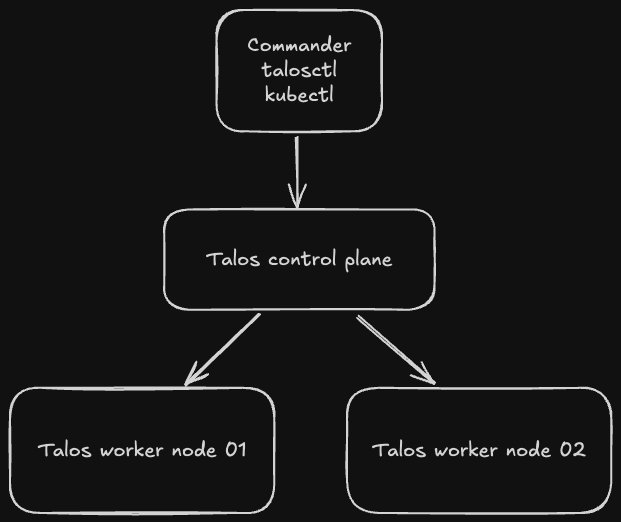
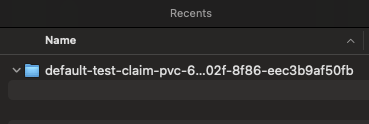 Note: If you change the archiveOnDelete to true that will rename the folder to archived after the pvc deleted. And if using a helm chart to install that will set as true by default.
Note: If you change the archiveOnDelete to true that will rename the folder to archived after the pvc deleted. And if using a helm chart to install that will set as true by default.